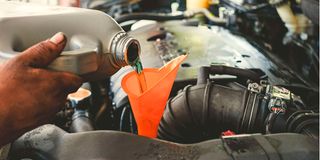Premium
How often should gear oil be changed? Your car holds the key

Gavin,
How often should engine oil be changed? I have been arguing with friends and researching online and everyone has a different answer. Research suggests it is somewhere between every 40,000 and 80,000 kilometres for manual gearboxes, and between 90,000 and 160,000 for automatics. Is that right or am I way off the mark? And are there factors other than just distance to take into consideration?
Peter
This is a difficult subject to get clear answers to, but there is one thing we can be sure of: gearbox oil does degrade – through distance, time, very high temperatures, metallic swarf from the gear cogs, and ingress of other impurities.
Through one or more or all of those factors, it does need to be changed, probably more often than most motorists realise.
What we lack is a single, clear and authoritative recommended change interval as a guiding principle for all vehicles in all conditions. The bracket of advice ranges from once every year to once every eight years, from every 20,000 kilometres to every 160,000 kilometres.
The manufacturer of your car will give one answer (a guess, because the need to change oil varies enormously depending on the vehicle, the severity of its use, and its condition), your mechanic will have his own idea, and the internet will broadcast all opinions, wise or woeful.
So, in that context, here is my own answer: Check the level of your gearbox oil at every routine service and also assess its condition. If it is degraded, change it. If it still looks, feels and smells as good as new, leave it alone. The same applies to the oil in your differentials, which are, after all, a kind of gearbox.
Gearboxes and diffs have an inspection/filler plug on one side, just above the correct fill level. If the level is full, some oil might dribble out when you remove the plug. Stick your finger (or a clean and preferably white prod) in the hole, you should be able to feel the pond of oil inside.
Then look at the oil on your finger or prod. It should be brightly coloured and semi-transparent. Rub the oil between your finger-tip and thumb. It should be absolutely smooth and consistent. Smell it. If it smells burnt, change it, and if the colour is dull or even slightly cloudy, change it. If there is any grittiness or any sense of unevenness in its viscosity or slipperiness, change the oil. And if you are not sure whether the oil needs changing or not, change the oil.
The new oil you put in will give better lubrication and protection than the old oil you drain out, even if only slightly (though maybe a lot). Changing the oil too often will cost you a few shillings, but changing it too seldom might cost you a small fortune in breakdown and repair. Do the math.
Symptoms to be alert for between services include stiffness of gear change or abnormal vibration or different sounds. These are also clues in an automatic box and can be accompanied by sluggish shifting or a change in kick-down response. In general, automatics need a gearbox oil change more often than manual gearboxes.
Things that can accelerate the degradation of gear oil include running at extra high temperatures (the burnt smell) because the oil level is too low, or driving style is exceptionally severe, or because extreme stress, for instance towing or overloading, has damaged some cog teeth or put some part of the gear mesh out of shape, or the vehicle’s regular motoring environment is so hot that normal air-cooling can’t cope.
Also, gearboxes and diffs have breathers which allow hot air out and cooler air in but are supposed to keep dust, dirt and water out. If these breathers are broken or jammed or missing, they can allow dirt and water in. You will tell if the colour is dull colour or cloudy.
However well-lubricated gear cogs are, they do operate under extreme pressures and they do suffer some wear. The minute quantities of metal swarf that are rubbed off their surfaces in use are suspended in the oil, and if they accumulate over time, they can act like very fine sandpaper, generating friction and heat that increase wear even further.
To minimise this, the drain plugs of gearboxes are magnetised to grab the floating bits of metal and hold onto (instead of recirculating) them. Gearboxes do also have filters, and interestingly, their manufacturers mostly recommend a change every two years.
These should be checked and usually changed and the magnetic drain plugs inspected and tested for their magnetism and cleaned when the gear oil is changed. Heat and severe shocks can degrade magnets.

Check the level of your gearbox oil at every routine service and also assess its condition. If it is degraded, change it. If it still looks, feels and smells as good as new, leave it alone.
To sum up, manufacturers’ recommended change intervals are not wrong, nor can they be precisely right for everyone. The condition of your gearbox oil is the best and possibly the only reliable guide to change intervals. As a default, a change at least once every two years should be adequate for most cars.
Here’s why a brand new car needs to be run in…
I read somewhere that new cars need to be “run in” to get them to function optimally. Aren’t brand-new vehicles in perfect condition?
Daniel Musila
Short answer: Cars are at their very best when they are new and have been diligently “run in” as well as had their special First Service and driven a little bit longer and more quickly. Modern materials and manufacturing techniques can achieve extremely high levels of precision but they are still not perfect.
Surfaces that rub against each other, such as pistons and cylinder walls, brake pads and discs, clutches and thrust bearings, gear shafts and cogs and all other bearings and shafts and seals, need to bed in together, with the actual parts that they will spend the rest of their lives working with.
While they do so, they suffer a higher rate of wear and generate higher temperatures, damaging hot-spots. Gentle use under light loads will minimise this, harsh driving generating high loads will maximise it and potentially scar some surfaces.
Longer answer: For a deep-tech understanding, you need to word-search “tribology” – the science that studies the interaction between surfaces and the principles of friction, lubrication and wear. Also look up “asperity of materials” for some sketches of what even polished surfaces look like under a microscope.
In more down-to-earth terms, no matter how perfect and smooth a surface looks to the eye and feels to the touch, under a microscope it won’t be a flat line – it will look more like a cross-section of the Himalayas. If you were microscopically small, walking on even a mirror surface would be like taking a stroll on the Shetani Lava Flow in Tsavo West.
The irregularities on metal surfaces might be incredibly small, but they have millions of little peaks and valleys. That applies to everything, including the sides of a piston and the inner walls of a cylinder sleeve.
The difference between the highest and lowest points may be only a tiny fraction of the thickness of a human hair, but when two surfaces touch, these microscopic projections and indentations rub against each other like two sheets of face-to-face sandpaper. Further enlarged, the contact area would look like two saws being rubbed together, tooth-to-tooth.
At a microscopic level they are snagging and bashing and knocking the tips off each other. And the heavier the load and speed of their interaction, the rougher and more damaging the consequences will be. Because the contact area between the tips is small, the loads are especially high until the spiky bits become blunter.

Cars are at their very best when they are new and have been diligently “run in” as well as had their special First Service and driven a little bit longer and more quickly.
Once the spikes have been worn down, the area of load-bearing contact increases (more evenly spread) and the irregularities between the two surfaces are more compatible with each other. And the oil between the two surfaces is less thrashed.
Running-in techniques
Drive gently in every respect - acceleration, revs, speed, braking, gear changing, clutch engagement and release. Do not rev the engine when it first starts. Move off immediately but especially gently until the oil is well distributed and warming. Initially, do lots of short and variable trips rather than steady long journeys, so any potential hot-spots don’t develop too far between gear and speed changes, and maximise the cool-down pauses between runs.
After a few hundred kilometres you can progressively increase the use of power and pace. After a thousand kilometres, give the car its first service without delay. The bedding-in process will have generated lots of metal swarf as surfaces that microscopically looked like the peak of Batian have now been buffed to the shape of the Ngong Hills.
So thoroughly flush all the oils and change the filters, and check all important adjustments after the initial rub-down and shake-down.
Even after that, some aspects will continue to improve for several thousand kilometres more, especially the flexibility of engine performance at high revs. That is why no one, least of all the richest factory teams, have ever put a brand new car on the start ramp of a rally, they run-in the car thoroughly many weeks in advance.
On good quality modern cars, none of this is a life-and-death issue, but it will optimise the condition of your car, especially the engine and gearbox, and extend its healthy life. By how much, you may wonder?
There are too many subsequent variables to give a specific answer to that, but here are a couple of indicators:
First, that most makes will void their warranty if the first service is not conducted within a distance limit. That tells you how much detritus will be generated – and needs to be removed – after the first few hundred kilometres.
Second, makers of very high performance cars are concerned their new owners might not be patient enough to start slowly, and will want to promptly lay down some rubber in true Ferrrrrrari style, so they put the cars on dynamometers (rolling roads) while they are still in the factory, run them in, and give them a full first service and readjustment before they are sent to the showroom!
Would they do that if it did not matter?





